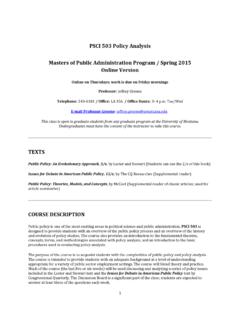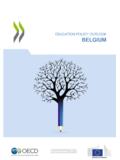Transcription of UNITED KINGDOM - OECD
1 UNITED KINGDOM Key findings The UNITED KINGDOM performs around the average in mathematics and reading and above average in science, compared with the 34 OECD countries that participated in the 2012 PISA assessment of 15-year-olds. When compared with PISA 2006 and PISA 2009, there has been no change in performance in any of the subjects tested. (The PISA 2000 and 2003 samples for the UNITED KINGDOM did not meet the PISA response-rate standards, so the observed higher performance in 2000 should not be used for comparisons.) The UNITED KINGDOM is listed 26th in mathematics performance, but because results are based on a sample, its relative position could be between 23rd and 31st. Its performance is similar to Czech Republic, Denmark, France, Iceland, Republic of Ireland, Latvia, Luxembourg, New Zealand, Norway and Portugal.
2 The UNITED KINGDOM has a higher GDP and spends more on education than the average in OECD countries, as well as higher levels of tertiary education and a lower share of the most socio-economically deprived groups. However, these comparative advantages do not have a clear relationship with educational outcomes. As in many other countries, socio-economically disadvantaged students in the UNITED KINGDOM are less likely to succeed at school than their more advantaged peers. However, some countries are more successful than the UNITED KINGDOM in reducing the influence of socio-economic status on student performance. On the other hand, students from an immigrant background (first or second generation) in the UNITED KINGDOM perform as well in mathematics as other students.
3 This is in contrast to the situation observed in many other OECD countries, where students from an immigrant background score significantly lower. Students in the UNITED KINGDOM are generally positive about their experiences at school and about the climate in their classrooms. As in many other countries, they are much less positive about learning mathematics, although students in the UNITED KINGDOM are less anxious about mathematics than the average across OECD countries. Girls in the UNITED KINGDOM do not enjoy mathematics, are anxious when asked to solve mathematical problems, and underperform compared with boys. Boys also outperform girls in science. Girls outperform boys in reading, although the gap is smaller than in many other countries. UNITED KINGDOM Country Note Results from PISA 2012 OECD 2 Student performance in mathematics, reading and science Mathematics performance Students in the UNITED KINGDOM score 494 points in mathematics, on average at the OECD average and comparable with the Czech Republic, Denmark, France, Iceland, Republic of Ireland, Latvia, Luxembourg, New Zealand, Norway and Portugal.
4 Mean performance in mathematics has remained unchanged since 2006 and 2009. The proportions of top performers (students who attain proficiency Level 5 or 6; who can develop and work with models for complex situations, and work strategically using broad, well-developed thinking and reasoning skills) and low performers (students who do not attain the baseline proficiency Level 2; these students can, at best, extract relevant information from a single source and can use basic algorithms, formulae, procedures or conventions to solve problems involving whole numbers) are similar to the OECD average. The proportion of top performers was 12% compared with an OECD average of 13% while the proportion of low performers was 22% compared with an average of 23%.
5 Boys in the UNITED KINGDOM outperform girls in mathematics by an average of 12 points, which is similar to the OECD average gender gap of 11 points. Scores for mathematics were similar in England (495) and Scotland (498). In both cases this showed little change from PISA 2009, where the scores were 493 and 499 respectively. The score in Northern Ireland was 487, compared with a score of 492 in PISA 2009. As in PISA 2009, mathematics performance in Wales was lower than the rest of the UNITED KINGDOM , with a score of 468 points compared with 472 in PISA 2009. Student performance in different areas of mathematics The UNITED KINGDOM s 15-year-old students do not show large differences in their scores on the three mathematical processes measured in PISA. They have the highest mean scores in interpreting, applying and evaluating mathematical outcomes.
6 They have the lowest mean scores in formulating situations mathematically, and perform close to their overall performance level in employing mathematical concepts, facts, procedures and reasoning. Of the four mathematical content areas assessed by PISA, UK students scored above their overall mathematics score in uncertainty and data, and scored similar to their overall mathematics score in the areas of change and relationships and quantity. Their performance in space and shape was somewhat below their overall performance. These strengths and weaknesses may reflect differences in curriculum priorities and in course content available to 15-year-olds. The space and shape subscale, where UK students struggle the most, is closely linked to geometry, but also draws on other areas, such as spatial visualisation, measurement and algebra.
7 Reading performance Students in the UNITED KINGDOM score 499 points in reading, on average at the OECD average and comparable with the Czech Republic, Denmark, France, Germany, Norway and the UNITED States. Mean reading performance has remained unchanged since 2006 and 2009. The proportions of top performers (students who attain proficiency Level 5 or 6; they can handle texts that are unfamiliar in either form or content and can conduct fine-grained analyses of text) and low-performers (students who do not attain the baseline proficiency Level 2; they can, at best, recognise the main theme or author s purpose in a text about a familiar topic and make a simple connection between information in the text and everyday knowledge) are similar to the OECD average.
8 The proportion of top performers was 9% UNITED KINGDOM Country Note Results from PISA 2012 OECD 3 compared with an OECD average of 8% while the proportion of low performers was 17% compared with an average of 18%. Girls outperform boys in reading by an average of 25 points, significantly less than the OECD average gender gap of 38 points. The score for reading in Scotland was 506 points, slightly higher than that in England (500), and Northern Ireland (498). This compares with scores of 500 in Scotland, 495 in England and 499 in Northern Ireland in PISA 2009. As in PISA 2009, reading performance in Wales was lower than the rest of the UNITED KINGDOM , with a score of 480 points compared with 476 in PISA 2009. Science performance Students in the UNITED KINGDOM score 514 points in science, on average above the OECD average and comparable with Australia, Austria, the Czech Republic, Ireland, the Netherlands, New Zealand, Slovenia and Switzerland.
9 Mean science performance has remained unchanged since PISA 2006 and PISA 2009. The proportion of top performers in science students who attain proficiency Level 5 or 6 was 11% in the UNITED KINGDOM , above the OECD average of 8%. At these levels, students can identify, explain and apply scientific knowledge and knowledge about science in a variety of complex life situations. At 15%, the proportion of low performers in science students who do not attain the baseline proficiency Level 2 is below the OECD average of 18%. At this level, students can, at best, present scientific explanations that are obvious and follow explicitly from given evidence. Boys outperform girls in science by an average of 13 points, which is a larger difference than the OECD average gender gap of 1 score point. Scores for science were 516 in England, 513 in Scotland and 507 in Northern Ireland.
10 This showed little change from PISA 2009, where the scores were 515, 514 and 511 respectively. As in PISA 2009, science performance in Wales was lower than the rest of the UNITED KINGDOM , with a score of 491 points compared with 496 in PISA 2009. Context Expenditure per student explains 30% of the variation in mean mathematics performance between countries. However, moderate or high spending per student cannot automatically be equated with particularly poor or high performance. For example, the Slovak Republic, which spends around USD 53 000 per student, performs at the same level as the UNITED States, which spends over USD 115 000 per student. Similarly, Korea, the highest-performing OECD country in mathematics, spends well below the average per-student expenditure. The UNITED KINGDOM spends more per head on education than the average across OECD countries, with a cumulative expenditure per student between 6 and 15 years at USD 98 023.














